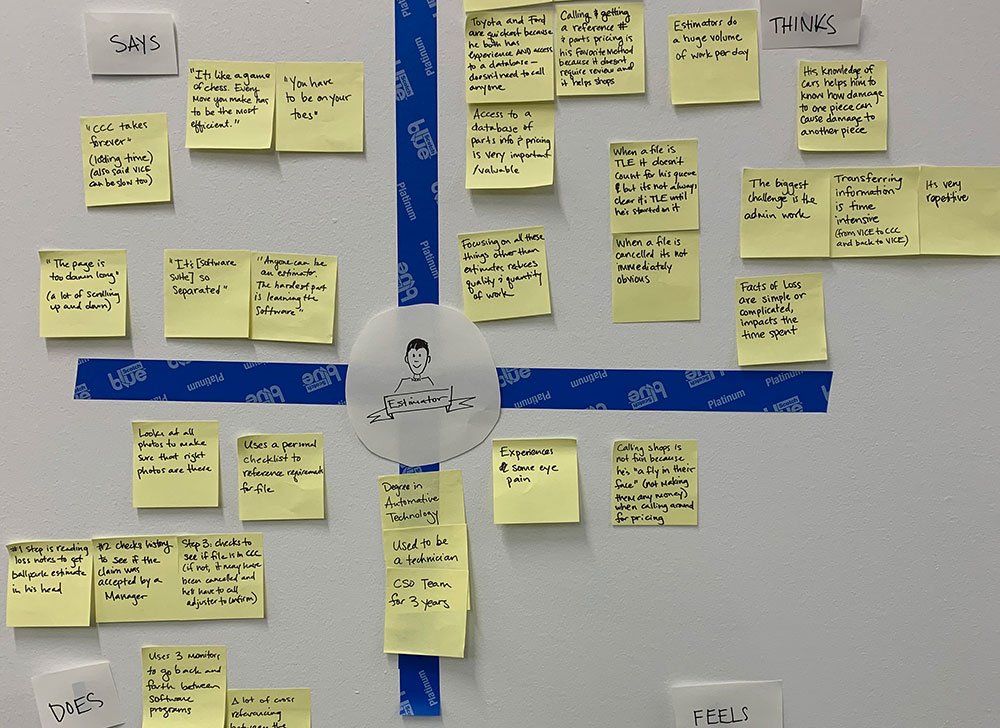
Snapsheet
Every day, Snapsheet's team of in-house Claims Adjusters processed a large volume of auto insurance claims. Customer Service Specialists facilitated the work by gathering information and saving it in a customized database. When the required information had been collected, the database would notify the Claims Adjuster, and pass the claim to their desk.
The Goal
Our objective was to develop Snapsheet’s homegrown software into a marketable industry standard, supporting the entire claims process for our automotive insurance clients with efficient, powerful task management software.
My Role
Senior User Interface and User Experience Designer, UX Researcher, Lead Designer on the task management design track, UX Research Evangeilst
Discovery
Competitive Analysis & Internal Alignment on Objectives
We initiated the project with a good, thorough competitive analysis. Upon receiving our objective, we looked for inspiration and insights from complex databases and task management software such as AWS, Salesforce, Monday.com, Jira, Asana, and Humanity. After distilling some key feature similarities, we as a design team hosted a white-boarding session with our Product Manager and developers to draft more granular objectives for the software.
User Research
We began with our most accessible resources by shadowing our in-house Customer Service Agents while they used the beta version of the product. User research was new to Snapsheet, so I developed a business case, which I presented to internal stakeholders to foster an understanding of what user research is and how it can be useful. We gained clearance to conduct surveys and ethnographic studies with customer service specialists (CSS) and Claims Adjusters.
We entered the studies to learn more about the tools, needs, expectations, jobs, workflow, shortcuts, blockers, and hardware that are currently utilized, and weigh those against the hypotheses we developed in the white-boarding session.
We discovered that a lot of nuanced information had to be passed between CSS and Adjusters, that most claims are not black and white. We also learned that tasks were so nuanced and the interface was so complex that Adjusters often had to send the claim back to CSS to gather information that had been missed.
Usability Testing
Along with our Business Analyst, I traveled to Ireland to spend a week with our pilot clients. We spent an intensive week studying the teams’ process and how our product performed in context. In the following week, we synthesized our data using affinity mapping, identified key areas for improvement, presented the findings to senior leadership, and worked with Product Managers to define an impact-feasibility matrix to set the roadmap up for success.
Results
The software we designed was utilized by The Hertz Corporation and processes over 1,000 assignments per day during the first month of launch.
Managers were able to set profiles one time, and tasks automatically flowed to the correct employees
Setting profiles, permissions, and hierarchy using the skeuomorphic slider design that I developed drew on real-world spatial knowledge, and proved easy and intuitive to use
Employees were able to increase their efficiency in accessing and completing their tasks
Solution
We designed a multi-layered profile solution, which enabled Administrators to identify teams and skillsets that would automatically match actors to appropriate tasks utilizing a skeuomorphic slider interface design. If the top choice for the task was fully booked according to their adjustable cadence and threshold for task assignment, the software would automatically "overflow" from one team to the next based on urgency, quantity, and graded proficiency.
When the task reached the Adjuster’s desk, their interface would break tasks into logical groups that would empower a smooth workflow. A visual hierarchy utilizing color contrast and spatial relationships was controlled by a left-sidebar checkbox filtering system.




